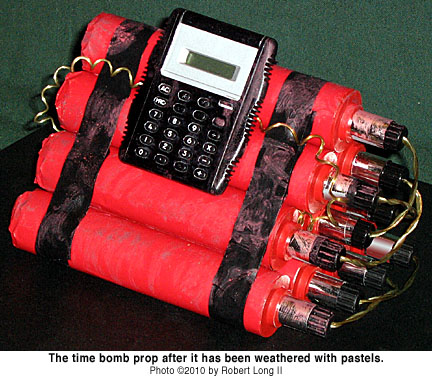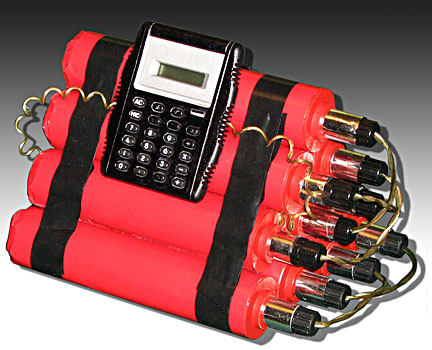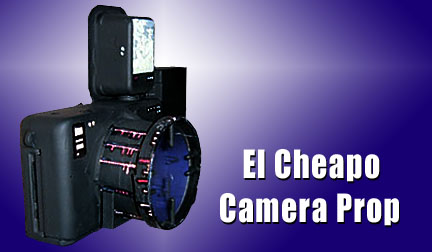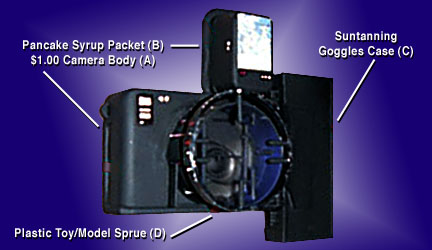Search
Props needn’t cost a production a lot of money, but they can really add a lot of production value – especially to low budget independent films. This thread will have various props that have been built for real projects.
Take for example the image you see above. This bomb prop is for use in the 3rd episode of “Adventures of Louanna Lee” (a Lee Doll Production). In one important scene there is supposed to be a time bomb that is counting down to go off. Knowing that I had to keep costs down, how what Igoing to pull this prop off? Here’s the secret: I have a junk box I keep filled with odd items just for this kind of situation.

The time bomb prop consists of the following items: 10 print ribbon rollers from a Rimage printer, stereo speaker wire, a broken calculator, red wrapping paper, black electrical tape, a little red and black paint, Scotch tape, and white glue. The tools I used were a pair of scissors, a marker, a straight edge, and a Dremel tool.
Rather than go into lengthly detail, I wanted to offer this up as to what you can do with a few found objects and some imagination. About the only other thing I am going to do is weather it up a bit with pastels and dirt to give it some wear and grunge. With a little thought and elbow grease you can add a tremendous amount of visual interest to your production. – Robert Long II, Production Designer
By Joe Sherlock ©2010. Used with permission. Edited by Robert Long II
I’m having someone shoot some footage for me and it involves a semi-professional photographer character. The person shooting said they didn’t have a fancy camera so I figured I’d make a fake one to send them and it would look good enough on video.
So, I started with a cheapo film camera (A) I got at the Dollar Tree.
Yes, it was $1.00.
In hindsight, I could’ve started with just a rectangular box. I had gone to the store hoping to find a toy camera and was about to give up after not finding one, then saw these real cameras and for some reason figured I’d get it and build on to it.
For the flash, I used a pancake syrup container (B) – in the photo, you are seeing the bottom of it: the peel-off lid was on the backside. It was attached with some strips of duct tape and some model glue.
For kind of a handle/battery pack kind of thingee, I used a small plastic box (C) that used to hold the suntanning goggles that “Tulsa” from BLOODSUCKING REDNECK VAMPIRES wore. This was just attached with duct tape.
The lens was built up with some circular plastic rings leftover from some of my son’s toys (D). Not sure what exact toys they are from, but you know when you get plastic models and the small parts come on a kind of plastic grid (plastic sprue) and you wiggle and snap off the small parts? Well these rings had small parts on them and they’d been wiggled and snapped off. Anyhow, I put three of them together with duct tape, then taped the whole thing onto the front of the camera.
I painted the whole thing with a few coats of black latex paint – the thickness of the paint actually helped to hide some of the seams and tape edges. Then I painted the whole thing with flat black spray paint. Why flat? Just what I had on hand.
I’d taped off a rectangle for the “flashbulb” but when I peeled the gaffer’s tape I’d used of, it left a bunch of glue behind. Not much I could do about it, so I just left it.
I cut up a rectangular piece and a round piece of clear plastic from some packaging from one of my son’s toys. I used model glue to put the rectangular piece over the “flashbulb” and the round piece over the lens area. The model glue dried clear. My hope is that light will reflect of of these plastic pieces and push the illusion further on video.
The final touches were using a liquid paper pen, black marker and red marker to make some little dots, squares and such on the camera. I’m hoping that the lines and stuff on the lens look like all those focus marks on a real camera. On video, while being held by someone, with lights reflecting off of it, it should fool the audience. Joe Sherlock – Filmmaker

My sincere thanks to Joe Sherlock for allowing me to reproduce this camera article here. He is a talented and prolific artist with several low-budget productions under his belt; be sure to check them out! You can visit his independent movie site by clicking the Dr. Squid banner above.



